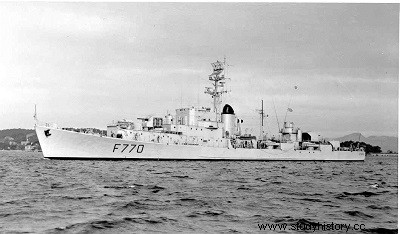
The term escort appeared during the Second World War to designate a warship, of medium or light displacement, whose mission was to protect ocean convoys and squadrons from attacks by submarines. This role was generally performed by escort destroyers such as the Buckley class and the Cannon class built in the United States, or the Hunt class built in the United Kingdom, or the River class frigates built in the United Kingdom. UK, Canada and Australia. The Imperial Japanese Navy used the name Kaibokan for this type of ship.
The escort ships of the French Navy After the war
Immediately after the war, to fulfill these escort missions, the French Navy only kept a handful of destroyers and destroyers. To these were added several ships of German and Italian origin recovered as war damage, and escort ships of British or American origin under various names:
escort destroyers (DE) of 1,500 tons, built in the United States;
frigates of 1,200 t (River class), built in the United Kingdom;
600 t corvettes (Flower class), built in the United Kingdom;
400 t coastal patrol boats (PC-461 class), built in the United States.
The two light cruisers of Italian origin Châteaurenault (D606) and Guichen (D607) took the name of squadron escort from 1955 until their disarmament in 1962 and 1963.
Building a new fleet
In the 1950s and 1960s, France therefore had to reconstitute its navy with the financial assistance of the United States, which financed most of the program. After some hesitation, the term "escort" will be chosen for this new type of warship, instead of the traditional "torpedo boat" or "counter-torpedo boat", which will be definitively abandoned.
The four families of escorts
18 squadron escorts (12 Class T 47, 5 Class T 53, 1 Class T 56):buildings of 3,000 tons, 128 to 132 meters long, for anti-submarine, anti-aircraft, radar picket or flotilla leader. They formed, until the end of the 1980s, the backbone of the high seas forces of the French Navy. They were destroyers for NATO (DD or DDG; hull number preceded by a D).
18 fast escorts (Type E50) and (Type E52):lighter vessels of 1,500 t, 99 m long, with anti-submarine vocation, types E50, E52A, E52B. They were frigates for NATO (FF; hull number preceded by an F).
9 escort sloops (Commandant Rivière class):vessels weighing 2,100 t, 103 m long, for anti-submarine and later anti-ship purposes, deployed overseas. They were frigates for NATO (FF; hull number preceded by an F)
14 coastal escorts (3 class Le Fougueux and 11 class L’Adroit) 400 t vessels, 52 m long. They were, for NATO, patrol boats or submarine hunters (PC Patrol Coastal; hull number preceded by a P).
The term "escort" is no longer used in the French Navy. It has been replaced by those of frigate, sloop or patrol boat.
